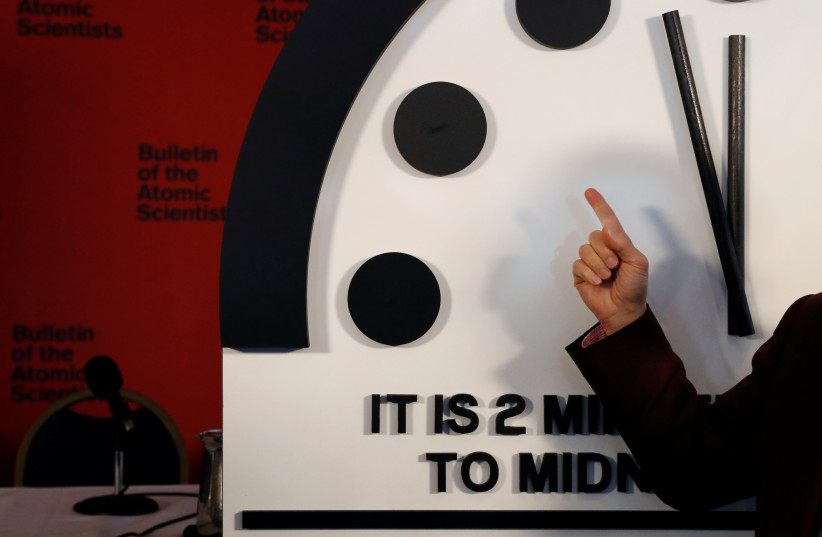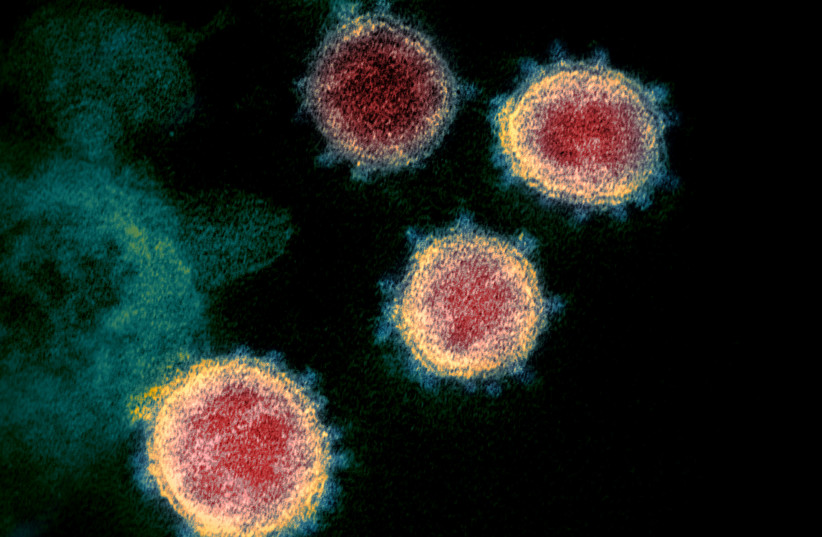Earth is closer to a catastrophic global demise than ever before, with the famous Doomsday Clock of the Bulletin of the Atomic Scientists being at 100 seconds to midnight.
The Doomsday Clock was first created in 1947 as a metaphorical countdown to the end of the world as we know it. Specifically, it refers to the impending global disaster that is solely caused by human hands, and it is adjusted every January upon review by scientists from the Bulletin.
Upon its unveiling in 1947, the clock was seven minutes to midnight. Since that time, it has moved back and forth a total of 24 different times.
Originally, the biggest factor at play in evaluating how close humanity is to its end was a nuclear apocalypse. This makes sense, considering it was formed right after nuclear bombs ended World War II and right before the arms race of the Cold War started. In fact, the record for the closest the Doomsday Clock had been to disaster used to be in 1953, set two minutes to midnight, when the US and Soviet Union both started to test hydrogen bombs.
This was seen again in 2018 when the clock once again moved back to two minutes to midnight in light of provocations between the US and North Korea pushing the chance of nuclear war even further.

Nowadays, it isn't just nuclear weapons that the Bulletin is concerned with. While the case in 2018 shows that nuclear weapons are far from irrelevant in the chance that humanity can thrust itself into a global armageddon, and it is likely the fastest way humans can do so.
A number of other issues are also factored into these estimates. Specifically, the factors nowadays that are being factored in are, aside from nuclear weapons, COVID-19, climate change and disruptive technologies.
This change to 100 seconds to midnight was first done in 2020. At the time, Bulletin executive chairman Jerry Brown pointed to both nuclear war and climate change.
"The dangerous rivalry and hostility among the superpowers increase the likelihood of nuclear blunder," he said. "Climate change just compounds the crisis. If there's ever a time to wake up, it's now."
Evidently, however, humanity has not done so. Since 2020, the Doomsday Clock has not changed from 100 seconds to midnight. This is because of the many factors mentioned above, which, despite some glimmers of hope at reversing this man-made impending disaster, were all made worse by "a corrupted information ecosphere that undermines rational decision making," the Bulletin noted in a statement.
Positive changes made in 2021 noted by Bulletin editor John Mecklin included new US policies made by the new Biden administration that included arms control deals, strategic talks with Russia, an attempted return to the Iran nuclear deal and rejoining the Paris climate accord. Especially positive, however, was a renewed emphasis on science and evidence in US policy-making, which is very notable regarding its handling of COVID-19.
But the situation is still tense.
Problematic factors include tensions with the US, Russia and China who are now all working to develop anti-satellite weapons and hypersonic missiles that could eventually lead to a new nuclear arms race in addition to making the problem of space debris much worse; North Korea's continued missile tests; Iran nuclear talks remaining unfruitful; and the ongoing Russia-Ukraine border tensions. There is also the fact that efforts have been made to develop biological weapons programs, something the Bulletin argues has marked the start of the biological arms race.
But that's just in the political sphere. Climate change is still a major factor, and despite many countries have pledged to reduce greenhouse gases, there is still much work to be done for there to be an impact.
This concern was highlighted in a report from late 2021 by the United Nations Intergovernmental Panel on Climate Change (IPCC) that warned that not only was the climate change issue not improving, but it is actually getting much worse. In fact, it is happening far faster than expected.
At the current rate, if global temperatures get to a certain point within the next five years, it could spark a positive feedback process that would make climate change self-sustaining.

Then, there is the issue of COVID-19.
While vaccine rollouts have seen responses to the pandemic improve on a national level, internationally the situation remains "entirely insufficient," according to Bulletin.
Poorer countries remain significantly unvaccinated. This, in turn, has led to the development of new variants. In particular, Delta and Omicron have been deadly and widespread, making the pandemic much worse as the virus continues to entrench itself.
This is further compounded with disinformation spread online, which is very problematic regarding battling the pandemic.
However, it is also a major threat to global democracy, something highlighted by the instability in the US that was sparked by rumors that Joe Biden did not win the 2020 elections. As noted by the Bulletin, "continued efforts to foster this narrative threaten to undermine US elections, American democracy in general, and, therefore, the United States' ability to lead global efforts to manage existential risk."
This is compounded by other technological threats, which include the use of surveillance technology, artificial intelligence and facial recognition systems. This is something the Bulletin specifically calls out China for using against the Uyghurs in Xinjiang, and notes that "the potential widespread deployment of these technologies presents a distinct threat to human rights around the world and, therefore, civilization as we know and practice it."
Also problematic are cybersecurity threats, such as the hacks on SolarWinds, Microsoft and the Colonial Pipeline.
But can something be done about it?
Maybe, and the Bulletin has made suggestions to push doomsday back.
These include, but are not limited to:
- Collaboration to limit nuclear weapons
- Eliminate the US president's sole authority in launching US nuclear weapons
- Both Iran and the US rejoining the 2015 nuclear deal
- Have Russia rejoin the NATO-Russia Council to push for risk-reduction measures
- Accelerating decarbonization efforts and live up to commitments
- Have China's Belt and Road Initiative push for sustainable development, not fossil fuel projects
- Public and private sectors alike should fund climate-friendly projects, not fossil fuels
- Citizens should hold leaders accountable and always ask what they are doing to address climate change
- Work with the World Health Organization and other groups to reduce biological risks, improve disease surveillance, expand hospital capacity and better production and distribution of medical supplies.
This list comes on the 75th anniversary of the Doomsday Clock's unveiling. In that time, we are now closer to a global manmade apocalypse than ever before.
"Without swift and focused action, truly catastrophic events — events that could end civilization as we know it — are more likely," the Bulletin said.
"When the Clock stands at 100 seconds to midnight, we are all threatened. The moment is both perilous and unsustainable, and the time to act is now."
Tzvi Joffre contributed to this report.
